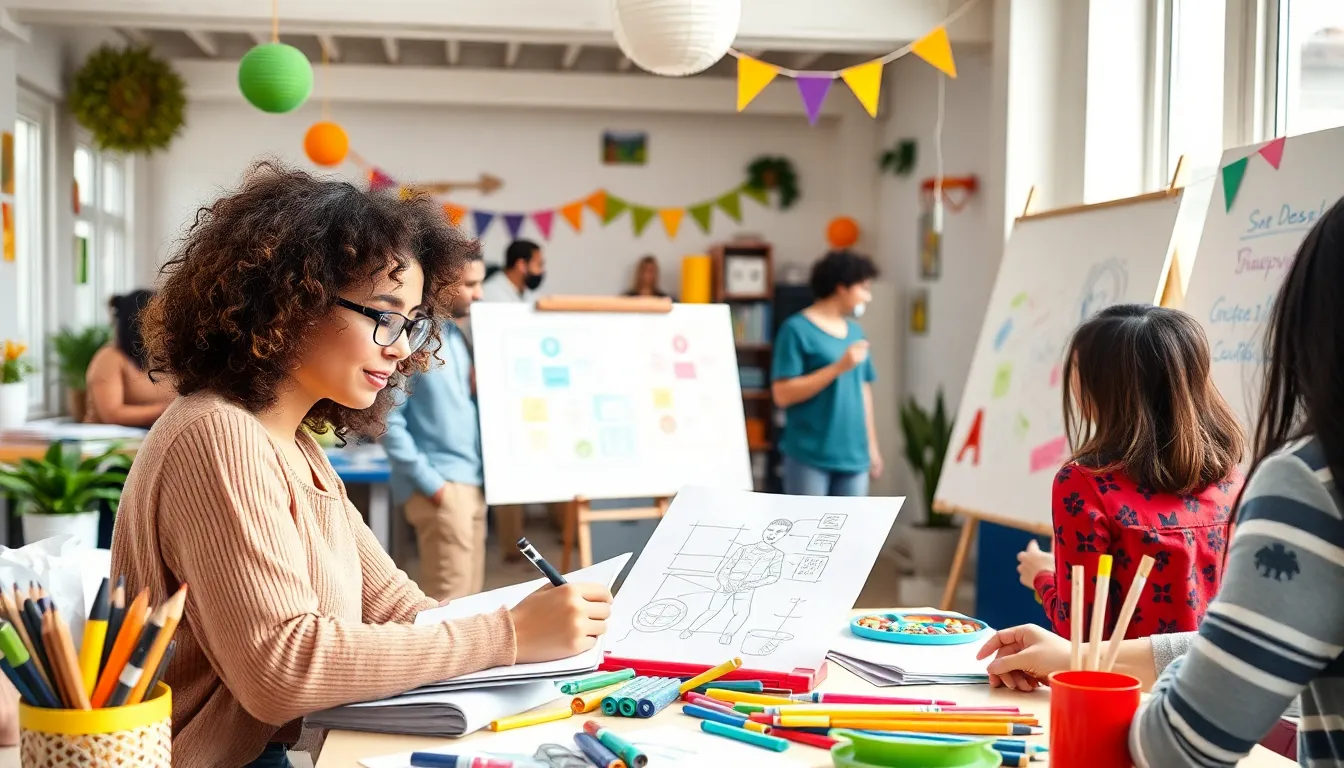Table of Contents
ToggleImagination is the secret sauce that fuels creativity and innovation. It’s that magical spark that turns ordinary moments into extraordinary adventures. Whether it’s dreaming up the next big invention or simply escaping into a world of fantasy, stimulating imagination can transform the mundane into the marvelous.
Understanding Imagination
Imagination plays a crucial role in the human experience, influencing creativity and innovation. It enables individuals to explore new ideas and possibilities beyond their immediate environment.
Definition of Imagination
Imagination refers to the mental ability to create images, scenarios, or concepts in the mind. This cognitive function allows people to envision what does not currently exist. It encompasses a range of activities from daydreaming to problem-solving. Children often exhibit their imaginative skills through play, while adults use them for artistic expression and strategic planning. The process of imagination involves synthesizing experiences and knowledge to generate original thoughts.
Importance of Imagination
Imagination serves as a pivotal driver of creativity and innovation in various fields. It fosters divergent thinking, allowing individuals to approach problems from multiple angles. Imagination not only supports artistic endeavors but also enhances scientific discoveries and technological advancements. Engaging the imagination leads to improved emotional resilience and enhances empathy by enabling individuals to consider different perspectives. Cultivating imagination in education and workplaces can result in more effective solutions and groundbreaking inventions.
Techniques to Stimulate Imagination

Imagination thrives through specific techniques that foster creativity. Engaging in structured exercises and maintaining a playful mindset can significantly enhance imaginative capabilities.
Creative Exercises
Participating in creative exercises sparks new ideas. Writing prompts encourage individuals to explore different narratives. Drawing or doodling provides visual stimulation. Brainstorming sessions allow for free association of thoughts. Engaging in role-playing can develop empathy and perspective-taking. These activities promote divergent thinking, pushing boundaries and yielding innovative solutions. Embracing structured routines like daily creativity challenges can maintain momentum.
Encouraging Playfulness
Fostering a playful environment supports imaginative growth. Allowing time for unstructured play can lead to spontaneous creative insights. Incorporating playful activities like improv games and playful art projects engages curiosity. Encouragement of experimentation without fear of failure nurtures a sense of exploration. Mixing different art forms can create unexpected crossovers that ignite imagination. Simple routines, like playful conversations among peers, can also inspire new ideas. When individuals embrace silliness, they often unlock deeper layers of creativity.
Role of Environment in Imagination
The environment plays a crucial role in shaping and enhancing imagination. Both physical and psychological aspects contribute to creative thinking and innovation.
Creating a Stimulating Space
A stimulating space ignites creativity. Bright colors and diverse textures can inspire ideas. Including elements like art, music, and natural light encourages exploration. Flexible seating arrangements foster collaboration. Personalizing spaces with individual touches improves emotional connection and enhances imaginative engagement. Creativity thrives in environments that offer comfort and curiosity.
Influence of Nature on Creativity
Nature significantly influences creativity. Studies show that spending time outdoors enhances mental clarity and innovative thinking. Green spaces provide a backdrop for reflection and relaxation, allowing the mind to wander freely. Natural sounds, like rustling leaves or flowing water, inspire tranquility, promoting deeper thought processes. Engaging with nature activates different cognitive pathways, leading to fresh perspectives and solutions. Embracing outdoor experiences enriches imaginative capabilities.
Benefits of Stimulating Imagination
Stimulating imagination yields numerous benefits that boost overall cognitive function and creativity.
Enhancing Problem-Solving Skills
Imagination plays a critical role in enhancing problem-solving skills. Participants generate creative solutions by visualizing different scenarios, allowing for unconventional thinking. Diverse approaches emerge when considering various viewpoints. Brainstorming sessions utilize this technique effectively, leading to innovative outcomes. Problem-solving benefits from the flexibility imagination provides, as individuals can adapt ideas to fit different contexts. Engaging in imaginative exercises encourages deeper analysis and understanding, making complex challenges more manageable. Studies reveal that imaginative play significantly improves critical thinking abilities, equipping individuals to tackle real-world issues.
Fostering Innovation
Innovation thrives in environments that encourage imaginative thinking. Original ideas often result when individuals explore new concepts without restrictions. Businesses and organizations that prioritize creativity excel at developing groundbreaking products. Flexible thinking allows teams to blend diverse disciplines, leading to unique solutions. Imagination fuels the creative process, guiding experimentation and exploration. Companies that cultivate an innovative culture achieve remarkable advancements by harnessing the power of imagination. Research indicates that diverse teams foster higher levels of creativity, emphasizing the importance of varied perspectives in driving innovation.
Stimulating imagination is essential for unlocking creativity and fostering innovation. By engaging in diverse activities and creating supportive environments, individuals can enhance their imaginative capabilities. Embracing playfulness and experimentation allows for fresh perspectives and innovative solutions to emerge.
Moreover, the influence of nature and a thoughtfully designed space cannot be underestimated in nurturing imaginative thought. As individuals cultivate their imagination, they not only improve problem-solving skills but also contribute to a culture of creativity that benefits both personal and professional growth. Ultimately, prioritizing imagination paves the way for extraordinary ideas and transformative experiences.







